
Johnny Depp at 50 (olsen-twins-news.com)
It’s always been my view that birthdays and anniversaries are affairs to be remembered. In fact, my own birthday is just around the corner, thank you very much. And with respect to anniversaries, this month marks the one-year anniversary of my blog. Hooray!!!
So let me celebrate both these occasions in grand fashion with a toast to one of my favorite film performers: Mr. John Christopher Depp Jr. or, as he’s known in the trade, Johnny Depp.
Wait! What’s that you say? Bad boy Jacky’s turned 50? Wow! Now that’s a milestone worth talking about! I certainly wish him well and many belated returns of the day. But what gives that his latest film feature – Gore Verbinski’s The Lone Ranger – is such a box-office dud? That’s not exactly what I’d call the perfect gift, now, is it?
Well, to be perfectly honest, Depp’s had his share of ups and downs, as well as hits and misses, during his nearly 29-year movie career. But 50 is such a nice, round number that it would be a shame not to take advantage of this opening gambit for a deeper examination into Johnny Depp’s cinematic output.
With a star of this magnitude, there are usually issues to be addressed and questions to be asked. For one, what makes Depp so popular with fans? For another, what attributes does he bring to his roles that continue to outshine his rivals? My thought is to provide readers with a fair and balanced glimpse of exactly how far this iconic figure has come – and how far he still has to go in his profession.
Life is What You Make It
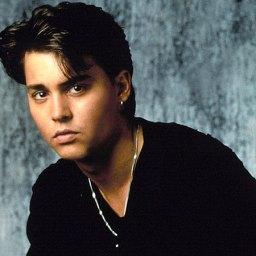
Depp in 21 Jump Street (tumblr.com)
Born in Kentucky on June 9, 1963, and the youngest of four kids, Depp and his family relocated numerous times until finally settling in Florida. But Junior didn’t stay put in the Sunshine State for long. With his parent’s subsequent separation and divorce, little Johnny was basically left to fend for himself. It was here that the kernel of the actor’s later alienation and notoriety was born.
A high school dropout, Depp changed venues to Los Angeles, where, after his initial contribution to a garage band floundered, he decided to take up acting. Landing a job as an extra in Hollywood, Depp’s so-called “big break” came in 1984 with a minor role in Wes Craven’s A Nightmare on Elm Street. Some labeled his intro to moviedom as “the end of a career before it even began,” but no matter.
A tiny part in Oliver Stone’s Vietnam War epic, Platoon (1986), led to an offer to co-star in the fledgling Fox Network’s detective series, 21 Jump Street (1987-89). This was the beginning of Depp’s image as a teen idol, one the young thespian rightly resented.
After a two-year stint, John jumped ship, as it were, to appear in director John Waters’ Cry-Baby (1990). A quirky follow-up to his earlier Hairspray from 1988, the cult favorite Cry-Baby (and the title character’s ability to cry on cue) served to establish Depp’s reputation as a heartthrob on the big screen, in addition to paying homage to his salad days as a rock-n-roller. It also made the young actor out to be a star on the rise, if not one to be watched.
Sensitive and Scarred
But the movie that firmly cemented those same teen-idol “creds” was Edward Scissorhands (1990). Sensitive and scarred, the impressionable Edward (charmingly played by Depp) is the scissor-handed Figaro for the laid-back California set (actually, Central Florida, a return to Johnny’s small-town roots).
The film is a modern parable of director Tim Burton’s pet hang-ups of having grown up in middle-class suburbia. It was also his and Johnny’s first joint venture, a partnership made in cinematic heaven and one of (at last count) seven movies they’ve participated in.
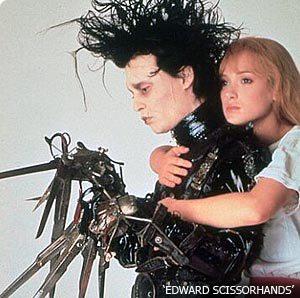
Depp & Winona Ryder in Edward Scissorhands
Depp had his best role ever as the misunderstood boy-monster, a walking textbook of physical deformities and psychological debilities, but with a cookie-cutter-shaped heart of gold. In essence, Edward is a Quasimodo for the nineties, an atypical success story driven to fits of anger and violence by the very townspeople he earlier had befriended. His story ends in death and tragedy, but Edward lives on, alone but happy in one of those stereotypical old mansions – blissfully trimming the verge as he goes.
An allegory of our own equal fascination with and fear of anything different or abnormal, Burton exploits Johnny’s sensitive side to the fullest. Indeed, his angst-derived interpretation of a misfit who just can’t fit in was spot on. When the perky Avon lady Dianne Wiest comes a-calling, only to discover Depp hiding under the ruins of what appears to be a window – with one of the window panes shaped like a broken cross – you know you’re in for a makeshift ride through pseudo-religious territory.
The Strange and the Idiosyncratic
Depp’s love and appreciation for silent cinema manifested themselves in Benny & Joon (1993), a wonderfully low-key feature. Billed as a romantic comedy, the film turned out to be director Jeremiah Chechik’s ode to silent-movie greats Charlie Chaplin and Buster Keaton, among others. As Joon, Mary Stuart Masterson was a last-minute replacement for Winona Ryder, after Ryder and Depp had broken up their ill-fated romance (which began on the Edward Scissorhands set). Joon is a mentally challenged young woman cared for by her overly protective older brother, Benny (sympathetically played by Aidan Quinn, another last-minute substitute).
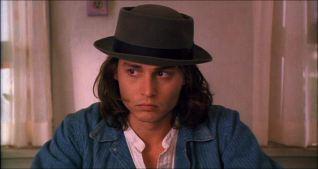
Depp as Benny (fanpop.com)
As the derby-wearing video employee Sam, Depp is relegated to supporting status, although he winds up becoming Joon’s love interest during the course of the film. With his eccentric persona and idiosyncratic behavior (i.e., making grilled-cheese sandwiches with a flat-iron), Johnny grabs the acting honors and wins moviegoers’ hearts – especially when he channels Chaplin’s fork-and-roll dance routine from The Gold Rush and Keaton’s hat-on-the-ground shtick. We come to the obvious conclusion that Sam and Joon were meant for each other (no kidding), despite Benny’s concern for his sister’s well-being.
It’s a patently sentimental tale that could have grown mawkish, but with the aid of Quinn, Masterson, and the dependable Julianne Moore, however, Benny & Joon can be seen as another feather in the developing Depp’s acting cap. Add to this an unusually catchy end song by the Scottish pop-rock band The Proclaimers (“I’m Gonna Be 500 Miles”) and you have a surefire hit, what is now politely referred to as a “date flick.” And who wouldn’t want a date with Johnny?
Only the Lonely
Speaking of date flicks, here’s one that’s strictly off the beaten path (if not totally off the wall): 1993’s What’s Eating Gilbert Grape? A character driven story that’s three-parts-drama to one-part-comedy, this film’s loaded with “the bizarre and the unusual,” to say the least. Depp plays the title role, the sanest member of the Grape family, a supposedly dysfunctional bunch that’s moored to a small mid-western town called Endora.
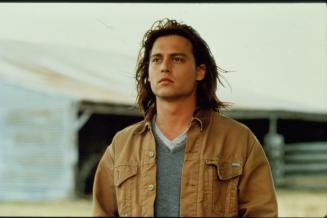
Depp as Gilbert Grape
Gilbert’s mentally challenged younger brother Arnie, amazingly played by Leonardo DiCaprio, is constantly getting himself into hot water. DiCaprio has the showier role (and how similar to Benny & Joon is the plot of this tale, with Depp taking over as the caring older brother). He’s followed by the engaging Juliette Lewis as Becky, Mary Steenburgen as the love-smitten older woman Betty, and the truly remarkable, 500-pound Darlene Cates, in her film debut, as Gilbert’s morbidly obese mother Bonnie, who hasn’t left the house since her husband’s suicide seven years earlier (!). Cates’ presence in the movie came about through her own real-life sad and lonely past.
The highpoint of the story is when Arnie finds himself atop a water tower and is thrown into the hoosegow for his disruptive action. This drives Bonnie to venture forth from the safety of her home, and confront her disapproving neighbors, in order to spring Arnie from jail, in what is a most bittersweet moment (that shot of Bonnie in the backseat of Gilbert’s van is priceless).
Though Depp’s easy affability and unsentimental take on the lead won critics over, it was DiCaprio who received the lion’s share of notices, along with an Academy Award nomination for Best Supporting Actor. The ending stretches credibility to the breaking point, but overall this film makes a nice companion piece to Depp’s supporting turn in Benny & Joon.
Freak Show
If you thought What’s Eating Gilbert Grape? was odd, wait till you get a load of this one! We come to quirkiness personified: Ed Wood from 1994, one of Johnny’s finest screen creations. Right from the opening scene, a fidgety, never-say-die enthusiasm surrounds the person of Edward D. Wood Jr. As the no talent outsider looking in, Wood is another of Depp’s classic portrayals of oddballs who either don’t belong in polite society or haven’t a clue as to why they can’t be like other folks.
Billed as the “worst director of all time,” Wood became famous, if that’s the right term, for his poorly acted, poorly scripted, ludicrously directed and abysmally edited fare. Despite the title character’s faults as a filmmaker, Depp uses his onscreen charm to make the most of Wood’s efforts and absurdities, and in the process makes him reasonably appealing to fans.
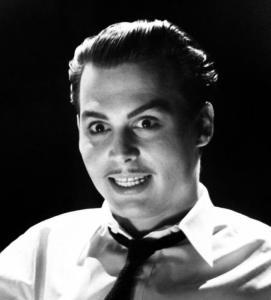
As Ed Wood (cineplex.com)
A disappointment at the box office, the movie wisely concentrates on Ed’s spur-of-the-moment friendship with the down-and-out Bela Lugosi, the centerpiece of the action. Another Tim Burton collaboration, the story line incorporates several of Wood’s notorious clunkers, among them Glen or Glenda, Plan 9 from Outer Space, and Bride of the Monster. Burton’s reenactments of these flicks are fairly close to the originals (but not too close, thank goodness), with some leeway here and there for individual interpretation.
Surrounding Depp is a veritable who’s who of supporting actors playing a laundry list of fellow losers, including Martin Landau as the track-marked Lugosi, Sarah Jessica Parker as Wood’s girlfriend, the talentless Dolores Fuller (the one with the angora sweater), Patricia Arquette as Wood’s other girlfriend, Kathy O’Hara (who doesn’t mind that Eddie has a sweater fetish), the buxom Lisa Marie as horror host Vampira, Jeffrey Jones as bogus psychic Criswell, Bill Murray as the fey Bunny Breckinridge, pro wrestler George “The Animal” Steele as man-mountain Tor Johnson, and Max Casella and Brent Hinckley as production assistants Paul Marco and Conrad Brooks.
Vincent D’Onofrio of Law & Order fame has a brief bit as Orson Welles. Otherwise, Depp (with or without his front teeth) is the cinematic glue that holds this disparate group together. Howard Shore wrote the clever theramin-based score and Stefan Czapsky provided the black-and-white photography. Incredible production designs perfectly capture the look and spirit of low-budget fifties movies at their (choke, gasp) “finest.” And remember, dear friends: it’s all based on sworn testimony!
(To be continued…)
Copyright © 2013 by Josmar F. Lopes

